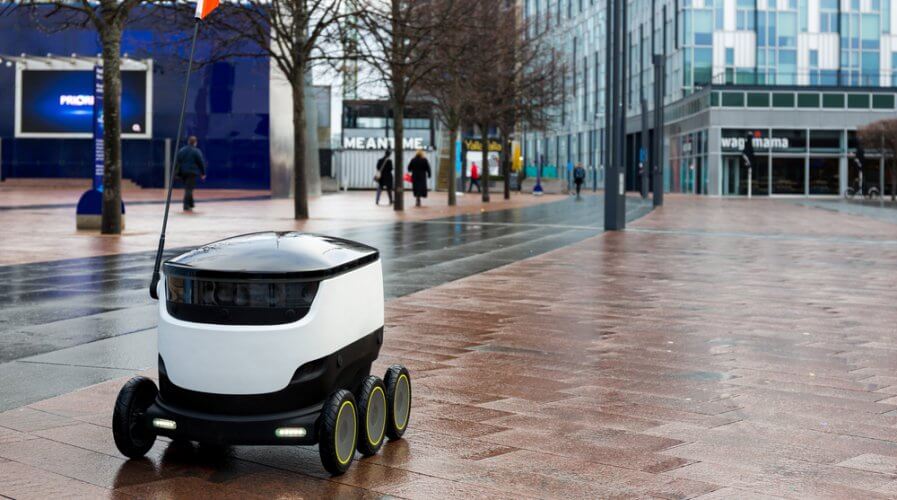
Autonomous delivery robots may be the solution to last-mile delivery challenges. Source: Shutterstock
Robots to deliver the last-mile for better retail CX
THE focus on last mile delivery for online retailers is one that could become their key competitive differentiator.
Rivalry in the e-commerce industry is intense. Big and small industry players are all becoming increasingly inventive to deliver an impeccable customer experience along with parcels.
Ultimately, all businesses could only gain market share when it has the support and loyalty of its consumers. Hence why the last point of contact that retailers have with consumers have grown in significance.
A McKinsey report claimed that some organizations are predicting that 80 percent of last-mile deliveries will be autonomous by 2025.
This week, FedEx announced its plan to launch a last-mile delivery pilot using autonomous delivery robots.
The logistics company will be collaborating with companies like Pizza Hut and Walmart to assess retailers’ autonomous delivery needs. If the test launch goes well, a larger scale of delivery robots will join the FedEx’s SameDay service.
The on-demand, hyper-local service is currently available in 1,900 cities. Locales with high density will benefit more from delivery robots.
“The FedEx SameDay Bot is an innovation designed to change the face of local delivery and help retailers efficiently address their customers’ rising expectations,” explained FedEx executive VP Brie Carere.
Some of the growing concerns relating to last-mile delivery for e-commerce businesses are traffic congestions, delivery cost, and poor visibility. Reoccurrence of these problems may thin out the customer experience and subsequently, the business.
A fleet of autonomous robots executing last-mile delivery is perhaps something that would lift some pressure off e-commerce business CXOs.
Here is how autonomous delivery robots may be able to deliver a greater customer experience for retailers.
#1 | Lower delivery costs
When compared to b2b, the last-mile service is often a single-parcel delivery that translates to high delivery costs. The amount is either borne by the e-commerce company or their consumers.
With delivery robots making the rounds instead, delivery costs are expected to be lowered. Regardless of the cost being absorbed by the retailer or its customer, a lower cost is always good news.
On top of that, robots will not require overtime wages. This enables logistics operations to maximize its productivity hours without incurring additional costs.
#2 | Quicker delivery time
The most common reason for customer complains is untimely delivery. If the product page states ‘to be delivered in 1-3 days,’ customers usually expect a shorter duration. The format of execution for delivery robots would already put hubs in closer proximity, lessening delivery time.
Machine learning-enabled delivery robots are often way smaller in size and will be able to use pedestrian paths instead. With smart cameras and LiDAR remote sensing technology, it will roll amongst pedestrians safely too.
It is safe to say that time equals money and that is especially true in business. The quicker retailers get done with one order, they will be able to allocate time and effort on another.
#3 | More accurate delivery tracking
The most tedious thing that retail customer service personnel may have to encounter is undelivered parcels. From case verification to refund or another delivery, it is a process that consumes time and resources unnecessarily.
The bleeding edge technology that delivery robots are equipped with are able to provide real-time updates. The tracking feature not only translates into better customer experience but also an assurance for retailers that they’ve successfully met their customers’ demands.
Online retail businesses that want to be at the forefront should really consider the use of autonomous last-mile deliveries.
The e-commerce industry will grow as developing parts of the world jumping onto the bandwagon. To keep up with rapid innovation, retailers must first resolve existing problems and optimize operations.
Delivering goods from logistics hubs to its final destinations using autonomous robots may be the solution to last-mile delivery challenges.
READ MORE
- Ethical AI: The renewed importance of safeguarding data and customer privacy in Generative AI applications
- How Japan balances AI-driven opportunities with cybersecurity needs
- Deploying SASE: Benchmarking your approach
- Insurance everywhere all at once: the digital transformation of the APAC insurance industry
- Google parent Alphabet eyes HubSpot: A potential acquisition shaping the future of CRM






